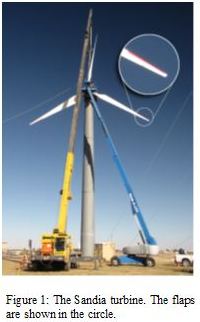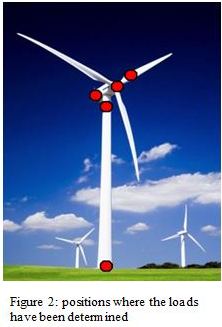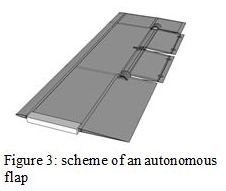
◀ Back to projects overview P201102-006-TUD
Smart Turbine
Public summary
Which problem is tackled?
Wind turbines convert kinetic energy of the wind into electrical energy. Unfortunately, this process is everything but constant, as the wind source shows large fluctuations with high and low frequencies. This turbulence, together with the wind shear and yawed inflow, excites the turbine structure, thereby driving the loads and the design of turbines in general and blades in particular. In response to this, several control mechanisms have been applied to wind turbines since the generation of stall controlled machines in the 1980s. While collective pitch control was applied first, the control mechanisms have become more localised and act on individual turbine blades, rather than on the rotor as a whole. An advanced control scheme is termed 'smart wind turbine'. These  types of wind turbines actively measures vibrations of its blades through a set of distributed sensors throughout the blades and then aims to counteract the vibrations using aerodynamic modifications around the blades' trailing edges close to the tips by means of control surface deflections. This project investigates several aspects of the smart rotor concept: the analysis of smart rotors, the design of an autonomous flap concept and the search for the most suitable load sensors, and finally an assessment of the impact on turbine design and Cost of Energy. The analysis and flap design are part of a PhD research (Lars Bernhammer, Cum Laude 12-10-2015), the load sensor study is a post-doc research (Aubryn Cooperman). The assessment on turbine design and CoE is done by the project partners XEMC-Darwind and ECN.
types of wind turbines actively measures vibrations of its blades through a set of distributed sensors throughout the blades and then aims to counteract the vibrations using aerodynamic modifications around the blades' trailing edges close to the tips by means of control surface deflections. This project investigates several aspects of the smart rotor concept: the analysis of smart rotors, the design of an autonomous flap concept and the search for the most suitable load sensors, and finally an assessment of the impact on turbine design and Cost of Energy. The analysis and flap design are part of a PhD research (Lars Bernhammer, Cum Laude 12-10-2015), the load sensor study is a post-doc research (Aubryn Cooperman). The assessment on turbine design and CoE is done by the project partners XEMC-Darwind and ECN.
Analysis of loads, fatigue damage, performance
For the analysis, a wind turbine analysis tool with special focus on smart rotors and controller implementation has been developed. This code, the Delft University Smart Wind turbine Analysis Tool (DU-SWAT), has been benchmarked not only against conventional wind turbine codes, but a successful comparison study with the first utility-scale smart rotor experiment, the Sandia National Laboratories Smart Rotor, see figure 1, was performed.
The individual flap controller has been tuned to the NREL 5MW reference turbine and has been used to study both fatigue and extreme loads according to the certification regulations. The fatigue load reduction of the blade root bending moment of 24% corresponds well with the findings of previous researchers. Figure 2 shows where the turbine loads have been assessed. Apart from the blade torsion all considered loads decreased or remained constant . The moments in the tower are also reduced. Besides load alleviation, an additional functionality of the smart rotor was established. The flaps can be used to increase the power production of the turbine by responding to fluctuations in the wind speed and the delays in the adjustment of the rotor speed due to the rotor inertia.  ]
]
The design and test of an autonomous flap
The second part of the project is the physical implementation of a flap system. The described flap system is fully autonomous and is mounted as a free-floating flap, which means that the flap can freely rotate around a hinge axis. The flap is controlled by a trailing edge tab and driven by servo actuators. The main advantage of the autonomous flap is its improved replaceability compared with non-autonomous ones. As it neither needs a connection to a central control unit and a power system, nor is an integral part of the wind turbine blades like seamless solutions, it can be exchanged easily in case of failure.
The evaluation of the impact oon the cost of Energy
The results of the previous work has been used to assess the reliability of the system and of the associated cost of maintenance and repair, which in turn is used as input in the assessment of the CoE effects of smart rotor technology for a 5MW offshore turbine. The most critical aspect of smart rotor technology is its reliability. Any failure followed by downtime of the turbine until repair is possible has a severe impact. A FMEA (Failure Mode  and Effect Analysis) has been carried out by XEMC-Darwind. When a flap fails and need to be replaced, the costs of the flap, the maintenance operation and an assumed downtime until quiet weather of 3 months, results in 8kEuro per year, including revenue loss. This offsets the positive effects of the load reduction, which is analysed by ECN using their turbine cost model and the O&M tool. The effect on the Levelised Cost of Energy (LCoE) is determined by inputting the results in the FLOW Cost model.
and Effect Analysis) has been carried out by XEMC-Darwind. When a flap fails and need to be replaced, the costs of the flap, the maintenance operation and an assumed downtime until quiet weather of 3 months, results in 8kEuro per year, including revenue loss. This offsets the positive effects of the load reduction, which is analysed by ECN using their turbine cost model and the O&M tool. The effect on the Levelised Cost of Energy (LCoE) is determined by inputting the results in the FLOW Cost model.
The result is negative: the LCoE increases 1.8%, despite the 8% lighter rotor. The main causes are:
- The additional costs of the flaps do not offset the lower blade costs
- O&M costs go up, availability goes down.
- Effects of the lower load spectrum on the nacelle and drive train have not been included as this requires a complete redesign of the turbine and its components. Given the results of cost- and reliability study, this was not yet considered to be valuable.
A break-even point is reached when the flaps cost less than k€ 22 and O&M costs do not increase.
The final result is that adding flaps to an existing turbine design has no added value. Only a dedicated turbine design exploiting the lower load spectrum in all aspects will be able to lower the LCoE.
Partners involved
- ECN
- TU-Delft
- XEMC-DarWind
Contact details
Mr. Ruud van Rooij
Project documents
Publications
![]() Paper - 7th PhD Seminar on Wind Energy 2011
Paper - 7th PhD Seminar on Wind Energy 2011
![]() Paper - 8th PhD Seminar on Wind Energy 2012
Paper - 8th PhD Seminar on Wind Energy 2012
![]() Paper - Journal of Aircraft 2013
Paper - Journal of Aircraft 2013
![]() Paper - Energy harvesting for actuators and sensors using free-floating flaps
Paper - Energy harvesting for actuators and sensors using free-floating flaps

 Share this page
Share this page
